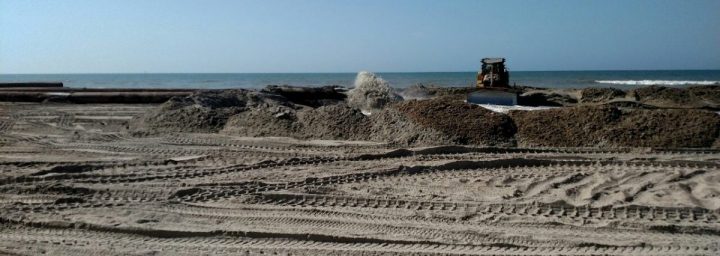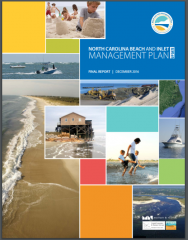
RALEIGH – Although there’s not a dime in it so far, the state has a new fund dedicated to beach re-nourishment and repair projects that supporters say could be the long-term solution to funding projects along the coast.
Earlier this month, when the legislature voted to override Gov. Roy Cooper’s veto of House Bill 56, the focus of debate was on controversial sections of the bill that funded local GenX testing and the repeal of a longstanding plastic bag ban on the Outer Banks. But among the dozens of provisions in H56 that became law with the override is the establishment of the Coastal Storm Damage Mitigation Fund, a new state special fund aimed at filling the gap caused by a steady drop in federal money for beach projects.
Supporter Spotlight

“It’s still a work in progress, but we think it’s going to be an important fund, a way to help out these local beach communities,” Rep. Pat McElraft, R-Carteret, said in an interview Tuesday. McElraft said that along with federal dollars for beach re-nourishment drying up, so have the state matches, and local communities are left shouldering too much of the burden.
This year, McElraft and other members of the coastal delegation have been making the case that maintaining the state’s beaches should be a more broadly shared obligation.
McElraft said the U.S. Supreme Court’s recent denial of an appeal in a case that challenged public access to state beaches underlines that right.
“These are truly public trust beaches, these are our state parks in the east,” she said. “People think beach re-nourishment is just about protecting homes, but it’s more about protecting public trust beaches.”
It is not that different than the state’s funding for firefighting to protect homes and state parks in the west, she said.
Supporter Spotlight
According to the law, the new fund, which is to be administered by the Department of Environmental Quality, will be used only for “costs associated with beach nourishment, artificial dunes, and other projects to mitigate or remediate coastal storm damage to the ocean beaches and dune systems of the State.”
Unlike most other special funds, the money for the new beach fund could come from a variety of sources in addition to state appropriations, including “gifts, grants, devises, monies contributed by a non‑State entity for a particular beach nourishment or damage mitigation project or group of projects.”
McElraft said while there was no appropriation for the new fund in this year’s budget, she expects the legislators to seek some kind of dedicated funding source as well as encouraging private contributions to the fund.
One potential source, she said, could come if the legislature reverses its 2013 decision to take away the portion of the deed stamp tax that formerly flowed to state parks. That reversal, which McElraft has lobbied for, could help create a reliable flow of revenue for the beach fund as well.
More Beach, More Money Needed
The idea of a dedicated state fund for beach re-nourishment is not new, but as federal funds ebb, the urgency has increased. During the same time, the amount of actual beachfront has expanded and with that, so have the costs.

According to the most recent update of the state’s Beach and Inlet Management Plan, or BIMP, about 38 miles of the state’s 74.8 miles of historically managed shoreline is the responsibility of state and local government. About 20 more miles of state and locally managed shoreline are planned, but not yet permitted. Along with the increase in miles, the federal share of the cost is expected to drop.
The BIMP update, released in December 2016, states that as a result, the annual cost of re-nourishment is expected to rise from $25 million to at least $40 million during the next few years. To handle the increase, the report recommended establishing a separate state beach re-nourishment fund with an expected annual contribution of $40 million to $60 million.
McElraft said even with a new dedicated funding stream, the amount of state money envisioned in the BIMP is unlikely.
“I don’t think we’ll ever see that kind of money,” she said.
The BIMP included a study of how much potential tax increases in the state’s eight beachfront counties would generate with a new 0.5 percent dedicated sales tax generating about $25 million annually and a new 1 percent meals tax bringing in about $15.1 million.
Unanswered Questions
Although it is now officially law, the new fund is on hold while DEQ officials study how it will be managed and where it will fit in the department’s structure and chain of command.
DEQ spokesperson Sarah Young said the department is still waiting on guidance from the General Assembly.
Also unclear is how the fund will be appropriated and how projects will be chosen.
Grady McCallie, policy analyst for the North Carolina Conservation Network, said since the new fund accepts outside money, it’s hard to find another fund in the state to compare it to. The law is too vague to know how it will ultimately be used.

“It could be used on folly or it could be used on wise adaptation to the future we face,” McCallie said. “There’s nothing in there to make it go one way or the other right now.”
One concern is the effect of private funds.
The law stipulates that the state has a two-year window to use non-state funds contributed for a specific project or group of projects. If the money has not been spent or encumbered by then, the contributor has the right for ask for it back, putting pressure on the state to prioritize projects or lose the private funds.
Also among the unanswered questions are what types of projects would qualify.
Earlier in this year’s regular session, House and Senate negotiators disagreed over whether the funds could be used for a terminal groin or other hardened structures.
A previous version of the provision approved by the House but opposed by the Senate specified that the fund could not be used for terminal groin projects. The new version appears to rule out funding for groins, but is less specific.

Existing state law prevents any use of state funds for groin projects, but in an interview in July during negotiations, Senate Majority Leader Harry Brown, R-Onslow, the new fund’s chief sponsor, said it might be possible that non-state money in the fund could be used for a terminal groin as part of damage mitigation or re-nourishment project.
McCallie said the section of the bill on what projects would qualify appears to remove the possibility for now that a groin project could be built with the funds.
The law preventing state funds for terminal groin projects and that would have to be altered to allow the state to use the new fund for such a project, he said.








